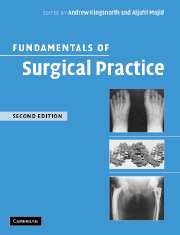Book contents
- Frontmatter
- Contents
- Preface
- Contributors
- 1 Preoperative management
- 2 Principles of anaesthesia
- 3 Postoperative management
- 4 Nutritional support
- 5 Surgical sepsis: prevention and therapy
- 6 Surgical techniques and technology
- 7 Trauma: general principles of management
- 8 Intensive care
- 9 Principles of cancer management
- 10 Ethics, legal aspects and assessment of effectiveness
- 11 Haemopoietic and lymphoreticular systems: anatomy, physiology and pathology
- 12 Upper gastrointestinal surgery
- 13 Lower gastrointestinal surgery
- 14 Hernia management
- 15 Vascular surgery
- 16 Endocrine surgery
- 17 The breast
- 18 Thoracic surgery
- 19 Genitourinary system
- 20 Head and neck
- 21 The central nervous system
- 22 Musculoskeletal system
- 23 Paediatric surgery
- Index
4 - Nutritional support
Published online by Cambridge University Press: 15 December 2009
- Frontmatter
- Contents
- Preface
- Contributors
- 1 Preoperative management
- 2 Principles of anaesthesia
- 3 Postoperative management
- 4 Nutritional support
- 5 Surgical sepsis: prevention and therapy
- 6 Surgical techniques and technology
- 7 Trauma: general principles of management
- 8 Intensive care
- 9 Principles of cancer management
- 10 Ethics, legal aspects and assessment of effectiveness
- 11 Haemopoietic and lymphoreticular systems: anatomy, physiology and pathology
- 12 Upper gastrointestinal surgery
- 13 Lower gastrointestinal surgery
- 14 Hernia management
- 15 Vascular surgery
- 16 Endocrine surgery
- 17 The breast
- 18 Thoracic surgery
- 19 Genitourinary system
- 20 Head and neck
- 21 The central nervous system
- 22 Musculoskeletal system
- 23 Paediatric surgery
- Index
Summary
Any form of physical injury, including major surgery, multiple trauma and sepsis, is accompanied by increased requirements for nitrogen and energy. Patients in these situations require nutritional repletion from an early stage, even when their pre-insult nutritional status is normal. The parenteral (intravenous) route was considered to be the main route of nutritional support in surgical patients for many years. Over the last two decades it was recognized that other routes of nutritional support may be as appropriate in surgical patients as they are in other patient groups. Sip feeds and oral diet supplementation are important and useful ways of increasing nutrient intake, particularly in postoperative patients, and reduce the incidence of complications. However, for many surgical patients oral feeding is not appropriate – either through inability to eat or swallow (e.g. following orofacial surgery) or because of gastrointestinal (GI) dysfunction (e.g. postoperative ileus). Artificial nutritional support (provision of nutrient substrates by other than the oral route) is indicated for these patients. The two key options are – via the GI tract (enteral) or via the venous system (parenteral).
Malnutrition is a significant problem in hospitalized patients. Such malnutrition is of a mixed protein and energy deficit (protein-energy malnutrition (PEM)). Forty percent of patients are undernourished at the time of admission to hospital and over half of these have no nutritional data documented in their case notes.
- Type
- Chapter
- Information
- Fundamentals of Surgical Practice , pp. 50 - 57Publisher: Cambridge University PressPrint publication year: 2006



